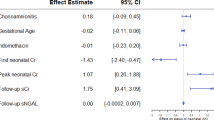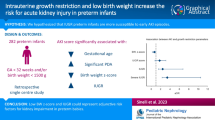Abstract
Objectives
Acute kidney injury (AKI) is a severe complication of prematurity, with currently unknown consequences for renal function in childhood. The objective of this study was to search for signs of reduced nephron number in children aged 3–10 years who had been born preterm with neonatal AKI and compare this group to control children.
Methods
IRENEO was a prospective, controlled study conducted in 2013 in Nantes University Hospital. Children who were born at less than 33 weeks gestational age (GA) and included in the LIFT cohort were eligible for entry. Twenty-five children with AKI (AKI-C) and 49 no-AKI children were matched on a propensity score of neonatal AKI and age. AKI was defined as a serum creatinine level higher than critical values: 1.6 mg/dl (GA 24–27 weeks), 1.1 mg/dl (28–29) and 1 mg/dl (GA 30–32). Renal function was evaluated during childhood.
Results
Mean age of the children at the time of the study was 6.6 years. No difference in microalbuminuria, estimated glomerular filtration rate (GFR) or pulse wave velocity was observed between the two groups. Renal volume was lower in the AKI-C group (57 vs. 68; p = 0.04). In the entire cohort, 10.8 % had a microalbuminuria, and 23 % had a diminished GFR (median 79 ml/min/1.73 m2). The GFR was lower in children with very low birth weight of <1000 g (99 vs. 107 ml/min/1.73 m2; p = 0.04).
Conclusion
In children born preterm, neonatal AKI does not seem to influence renal function. However, independent ofAKI, a large proportion of very preterm infants, especially those with very low birth weight, presented with signs of nephron reduction, thus requiring follow-up with a nephrologist.
Similar content being viewed by others
References
Zohdi V, Sutherland MR, Lim K, Gubhaju L, Zimanyi MA, Black MJ (2012) Low birth weight due to intrauterine growth restriction and/or preterm birth: effects on nephron number and long-term renal health. Int J Nephrol 2012:136942
Andreoli SP (2004) Acute renal failure in the newborn. Semin Perinatol 28(2):112–123
Mañalich R, Reyes L, Herrera M, Melendi C, Fundora I (2000) Relationship between weight at birth and the number and size of renal glomeruli in humans: a histomorphometric study. Kidney Int 58(2):770–773
Rodríguez MM, Gómez AH, Abitbol CL, Chandar JJ, Duara S, Zilleruelo GE (2004) Histomorphometric analysis of postnatal glomerulogenesis in extremely preterm infants. Pediatr Dev Pathol 7(1):17–25
Brenner BM, Lawler EV, Mackenzie HS (1996) The hyperfiltration theory: a paradigm shift in nephrology. Kidney Int 49(6):1774–1777
Bacchetta J, Harambat J, Dubourg L, Guy B, Liutkus A, Canterino I, Kassaï B, Putet G, Cochat P (2009) Both extrauterine and intrauterine growth restriction impair renal function in children born very preterm. Kidney Int 76(4):445–452
Rodríguez-Soriano J, Aguirre M, Oliveros R, Vallo A (2005) Long-term renal follow-up of extremely low birth weight infants. Pediatr Nephrol 20(5):579–584
Keijzer-Veen MG, Kleinveld HA, Lequin MH, Dekker FW, Nauta J, de Rijke YB, van der Heijden BJ (2007) Renal function and size at young adult age after intrauterine growth restriction and very premature birth. Am J Kidney Dis 50(4):542–551
Keijzer-Veen MG, Schrevel M, Finken MJJ, Dekker FW, Nauta J, Hille ETM, Frölich M, van der Heijden BJ, Dutch POPS-19 Collaborative Study Group (2005) Microalbuminuria and lower glomerular filtration rate at young adult age in subjects born very premature and after intrauterine growth retardation. J Am Soc Nephrol 16(9):2762–2768
Iacobelli S, Loprieno S, Bonsante F, Latorre G, Esposito L, Gouyon JB (2007) Renal function in early childhood in very low birthweight infants. Am J Perinatol 24(10):587–592
Zanardo V, Fanelli T, Weiner G, Fanos V, Zaninotto M, Visentin S, Zanardo V, Fanelli T, Weiner G, Fanos V, Zaninotto M, Visentin S (2011) Intrauterine growth restriction is associated with persistent aortic wall thickening and glomerular proteinuria during infancy. Kidney Int 80(1):119–123
Keijzer-Veen MG, Finken MJJ, Nauta J, Dekker FW, Hille ETM, Frölich M, Wit JM, van der Heijden AJ, Dutch POPS-19 Collaborative Study Group (2005) Is blood pressure increased 19 years after intrauterine growth restriction and preterm birth? A prospective follow-up study in The Netherlands. Pediatrics 116(3):725–731
Kandasamy Y, Smith R, Wright IMR, Lumbers ER (2013) Extra-uterine renal growth in preterm infants: oligonephropathy and prematurity. Pediatr Nephrol 28(9):1791–1796
Chan PYL, Morris JM, Leslie GI, Kelly PJ, Gallery EDM (2010) The long-term effects of prematurity and intrauterine growth restriction on cardiovascular, renal, and metabolic function. Int J Pediatr 2010:280402
Barker DJ, Gluckman PD, Godfrey KM, Harding JE, Owens JA, Robinson JS (1993) Fetal nutrition and cardiovascular disease in adult life. Lancet 341(8850):938–941
Barker DJP (2003) The developmental origins of adult disease. Eur J Epidemiol 8(8):733–736
Hoy WE, Rees M, Kile E, Mathews JD, Wang Z (1999) A new dimension to the Barker hypothesis: low birthweight and susceptibility to renal disease. Kidney Int 56(3):1072–1077
Lurbe E, Torro MI, Carvajal E, Alvarez V, Redón J (2003) Birth weight impacts on wave reflections in children and adolescents. Hypertension 41(3 Pt 2):646–650
Lunn AJF, Shaheen I, Watson AR (2006) Acute renal insufficiency in the neonatal intensive care unit. Arch Dis Child Fetal Neonatal Ed 91(5):F388
Cataldi L, Leone R, Moretti U, De Mitri B, Fanos V, Ruggeri L, Sabatino G, Torcasio F, Zanardo V, Attardo G, Riccobene F, Martano C, Benini D, Cuzzolin L (2005) Potential risk factors for the development of acute renal failure in preterm newborn infants: a case–control study. Arch Dis Child Fetal Neonatal Ed 90(6):F514–F519
Askenazi DJ, Ambalavanan N, Goldstein SL (2009) Acute kidney injury in critically ill newborns: what do we know? What do we need to learn? Pediatr Nephrol 24(2):265–274
Cuzzolin L, Fanos V, Pinna B, di Marzio M, Perin M, Tramontozzi P, Tonetto P, Cataldi L (2006) Postnatal renal function in preterm newborns: a role of diseases, drugs and therapeutic interventions. Pediatr Nephrol 21(7):931–938
Iacobelli S, Bonsante F, Ferdinus C, Labenne M, Gouyon J-B (2009) Factors affecting postnatal changes in serum creatinine in preterm infants with gestational age <32 weeks. J Perinatol 29(3):232–236
Vieux R, Hascoet J-M, Merdariu D, Fresson J, Guillemin F (2010) Glomerular filtration rate reference values in very preterm infants. Pediatrics 125(5):e1186–e1192
Gallini F, Maggio L, Romagnoli C, Marrocco G, Tortorolo G (2000) Progression of renal function in preterm neonates with gestational age < or = 32 weeks. Pediatr Nephrol 15(1–2):119–124
Walker MW, Clark RH, Spitzer AR (2011) Elevation in plasma creatinine and renal failure in premature neonates without major anomalies: terminology, occurrence and factors associated with increased risk. J Perinatol 31(3):199–205
Abitbol CL, Bauer CR, Montané B, Chandar J, Duara S, Zilleruelo G (2003) Long-term follow-up of extremely low birth weight infants with neonatal renal failure. Pediatr Nephrol 18(9):887–893
Bruel A, Rozé J-C, Flamant C, Simeoni U, Roussey-Kesler G, Allain-Launay E (2013) Critical serum creatinine values in very preterm newborns. PLoS One 8(12):e84892
Austin PC (2011) A tutorial and case study in propensity score analysis: an application to estimating the effect of in-hospital smoking cessation counseling on mortality. Multivar Behav Res 46(1):119–151
Olsen IE, Groveman SA, Lawson ML, Clark RH, Zemel BS (2010) New intrauterine growth curves based on United States data. Pediatrics 125(2):e214–e224
Rademacher ER, Sinaiko AR (2009) Albuminuria in children. Curr Opin Nephrol Hypertens 18(3):246–251
Lurbe E, Cifkova R, Cruickshank JK, Dillon MJ, Ferreira I, Invitti C, Kuznetsova T, Laurent S, Mancia G, Morales-Olivas F, Rascher W, Redon J, Schaefer F, Seeman T, Stergiou G, Wühl E, Zanchetti A, European Society of Hypertension (2009) Management of high blood pressure in children and adolescents: recommendations of the European Society of Hypertension. J Hypertens 27(9):1719–1742
Reusz GS, Cseprekal O, Temmar M, Kis E, Cherif AB, Thaleb A, Fekete A, Szabó AJ, Benetos A, Salvi P (2010) Reference values of pulse wave velocity in healthy children and teenagers. Hypertension 56(2):217–224
Fischer D-C, Schreiver C, Heimhalt M, Noerenberg A, Haffner D (2012) Pediatric reference values of carotid-femoral pulse wave velocity determined with an oscillometric device. J Hypertens 30(11):2159–2167
Scholbach T, Weitzel D (2012) Body-surface-area related renal volume: a common normal range from birth to adulthood. Scientifica 2012:949164. doi: 10.6064/2012/949164
Vieux R, Hascoët J-M, Franck P, Guillemin F (2012) Increased albuminuria in 4-year-old preterm-born children with normal height. J Pediatr 160(6):923–928.e1.
Kwinta P, Klimek M, Drozdz D, Grudzień A, Jagła M, Zasada M, Pietrzyk JJ (2011) Assessment of long-term renal complications in extremely low birth weight children. Pediatr Nephrol 26(7):1095–1103
Staples A, LeBlond R, Watkins S, Wong C, Brandt J (2010) Validation of the revised Schwartz estimating equation in a predominantly non-CKD population. Pediatr Nephrol 25(11):2321–2326
McEniery CM, Bolton CE, Fawke J, Hennessy E, Stocks J, Wilkinson IB, Cockcroft JR, Marlow N (2011) Cardiovascular consequences of extreme prematurity: the EPICure study. J Hypertens 29(7):1367–1373
Cheung YF, Wong KY, Lam BCC, Tsoi NS (2004) Relation of arterial stiffness with gestational age and birth weight. Arch Dis Child 89(3):217–221
Filler G, Yasin A, Medeiros M (2014) Methods of assessing renal function. Pediatr Nephrol 29(2):183–192
Shlipak MG, Matsushita K, Inker LA, Ärnlöv J, Katz R, Polkinghorne KR, Rothenbacher D, Sarnak MJ, Astor BC, Coresh J, Levey AS, Gansevoort RT, CKD Prognosis Consortium (2013) Cystatin C versus creatinine in determining risk based on kidney function. N Engl J Med 369(10):932–943
Author information
Authors and Affiliations
Corresponding author
Ethics declarations
Funding
There is no funding to report for this study.
Disclosure of potential conflicts of interest
The authors declare that they have no conflicts of interest.
Ethical approval
IRENEO was approved by the local ethics committee (nr. 2012-R25) and registered in a clinical trials register (NCT01785238). The LIFT cohort is registered at the French CNIL (Commission Nationale de l’Informatique et des Libertés, No. 851117).
All procedures performed in studies involving human participants were in accordance with the ethical standards of the institutional and/or national research committee and with the 1964 Helsinki declaration and its later amendments or comparable ethical standards.
Informed consent
Informed consent was obtained from all individual participants included in the study, and from their parents.
Rights and permissions
About this article
Cite this article
Bruel, A., Rozé, JC., Quere, MP. et al. Renal outcome in children born preterm with neonatal acute renal failure: IRENEO—a prospective controlled study. Pediatr Nephrol 31, 2365–2373 (2016). https://doi.org/10.1007/s00467-016-3444-z
Received:
Revised:
Accepted:
Published:
Issue Date:
DOI: https://doi.org/10.1007/s00467-016-3444-z




